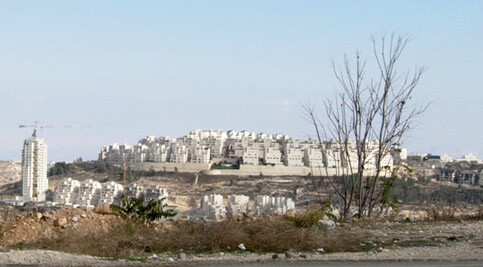
Two kilometers outside Bethlehem, coming in from Jerusalem, is Jebel Abu Ghneim, which was once a green forest with 60,000 pine trees, and hundreds of animals and plants. The land’s owners are from Bethlehem, Beit Sahour, Sur Baher and Um Tuba. In 1997, the Israelis began destroying the forest by uprooting all the trees in order to build Har Homa settlement. Now I see there is new construction at the bottom of the mountain as well. (Emily Jacir)
I was 13 years old standing next to my father in Bethlehem one sunny and windy day when he took my hand and pointed to the settlement of Gilo and said, “See baba, see there?” My eyes followed his finger as it moved across the landscape and stopped at the settlement of Har Gilo. “And there. See? They are going to build settlements just like those all around us.” Then with his arm still outstretched, we turned in a circle and as I watched his finger pointing at the horizon line around Bethlehem and Beit Jalla, he added, “One day they will encircle us.”
This essay is for my father Yusuf Nasri Suleiman Jacir. My father who taught me what it means to be free, what justice is, how to fight, and who gave me his love for Palestine. He is my biggest hero. He is the most giving and loving person I have ever known in my entire life. His first priority has always been his family and he did anything he could to make us happy.
If he could have done what he wanted in his life he would have been a professor. That was his dream. For him this was the highest and most honorable profession. No one deserved more respect than a teacher. But a poor man from Bethlehem, with a family to support and family back home to take care of, could not afford to indulge in such bourgeoisie fantasies.
He fought hard to get where he is and he did it all by himself. Nothing was handed to him. He always had a lot of hardship in his life but he made it through and he did a great job. Because of him, I know that it is possible to do anything, at any age and that it is never too late.
My father was born and raised in Bethlehem where, although he came from a historically famous and wealthy family (our family tree goes back to 1500), he grew up poor. The Jacir family had gone bankrupt in the ’30s and lost absolutely everything. What remains of their legacy is the historic “Jacir Palace”. My great-grandfather Suleiman built it in 1910 with the intention that he and his five brothers’ families would all live in the house together, and they did for a short time but then the family lost everything and his dream was lost forever. Suleiman had quite a reputation around the region for his incredible generosity; everyone knew that if you were hungry you could go there and he would feed you.
I saw recently in an Israeli tourist guide the Jacir palace described as built by a “Turkish Ottoman Merchant” — not surprising as they are working on all fronts to erase and distort our history
The Jacir “palace” is currently owned by Padico and is an International Hotel but prior to this it has had an interesting history of occupants. In the ’40s the British used it as a prison. In the ’50s it was a private school called Al-Ummah, and in fact my grandfather Nasri taught there. Al-Ummah was originally located in Al-Baqaa’ in Jerusalem but after the 1948 catastrophe it was reborn in Bethlehem. Later the house became a government secondary boys’ school and then at a later stage was transformed in to a government girls’ school. Ironically, I saw recently in an Israeli tourist guide the Jacir palace described as built by a “Turkish Ottoman Merchant” — not surprising as they are working on all fronts to erase and distort our history.
My father did not have the opportunity to go to college until the age of 33. He was newly married with kids on the way, and working a full-time job and yet he managed to get his B.A.. He kept struggling so that eventually he got his masters degree at the age of 39 from the University of Chicago, which was a major achievement. Of course he could have never accomplished this without the help and support of my mother who worked a retail job selling clothes, and did things like hand sew clothes for us to wear. My father would work full-time and take night courses, and then he would come home where my mother would have dinner waiting for him. Right after he was finished eating, she would make him study until the wee hours of the morning. He said there was no way he could have done it without her. Her background was different then my father’s. She was well-educated at a young age and already had a bachelors degree at the time of her marriage. Her dream was to get a masters degree which she started to slowly work on after getting married.
Eventually my father decided he was willing to go and live in a country where he would be deemed a “guest worker” and be made to feel estranged. This was Saudi Arabia and he accepted it so that his kids could have a better life then he did. Most importantly, he wanted us to have a chance to have what he couldn’t get until he was in his mid-30’s — a college education. Saudi Arabia was not easy for my parents and they had to make huge sacrifices and adjustments. They were forbidden from practicing their religion and their culture. They were forbidden from holding hands, or displaying any signs of public affection. Their children could not study in an Arabic school because we were not Saudi nationals so the only option was the foreign schools. There was no cinema, no dance, and no theater. At one point my mother found out about a dance teacher who was secretly teaching and she immediately signed me and my sister up. But alas, the teacher was found out and promptly thrown out of the country (along with my eight-year-old dream of becoming a professional dancer). All foreign teenagers in the Kingdom of Saudi Arabia at that time were forced to leave to pursue their high school education outside the country as it was forbidden for them to stay. Coming from a traditional Bethlehem family, you can imagine what a sacrifice this was for my father to have to send his children away from him. It was unheard of and heartbreaking for him. I will never forget the day I left home for Italy at the age of 14, my father (who was always open and free with his emotions which is another reason he is my hero) wept openly as he hugged me good bye.
In Saudi Arabia, my mother could no longer pursue her masters degree and had to give that up. She managed, of course, and became the first Arabic teacher at the American School in Riyadh. She also got involved in several Saudi women’s groups. Best of all, she refused to wear the black abaya. She thought it was too dark and depressing and decided to make her own abaya. Her abaya was also black, and followed the rules by covering her body head to toe, but her abaya was covered in giant brightly colored flowers — they were pink, purple and green. When I was a young girl I was embarrassed at the way she stuck out of the crowd and wished she would wear a plain black one like me and my sister, but now when I look back at it I am proud.
We were near our homeland and for my father the most important thing was being able to go back as much as we could
But we were close to Palestine. We were near our homeland and for my father the most important thing was being able to go back as much as we could. We went back (sometimes three times a year) in the ’70s and ’80s via Jordan and the infamous bridge where I have many deep memories of being stripped searched as a child, and having things like my chewing gum confiscated. Working in Saudi Arabia also gave my father the ability to support his family still in Bethlehem. When I was growing up, he worked almost seven days a week, office hours were not 9 to 5, they were 8 a.m. to midnight. He would come home for dinner but then he would have to rush back to the office where I always felt he worked like a slave. In Bethlehem, it seemed our family and other people had no idea what our lives were like outside Palestine and I heard them say many things. It didn’t matter what we said; they had a fantasy in their mind about how we lived and nothing would change that. When I would complain about this to my mother, she would just quietly say “let them talk.”
I remember walking the streets of Bethlehem as a child and holding my father’s hands. I was always in awe as it seemed everyone knew him, everyone! My father never did resolve the fact that his children were growing up away from his parents and extended family. This fact hurt him and has always made him doubt if he made the right decision to leave Palestine.
Before my father got married and went to college he worked in Hebron from 1962 until 1969. He was working for UNRWA as the Area Welfare Officer for the Hebron and Bethlehem areas. The UNRWA headquarters was in Hebron and its area covered Bethlehem and all the surrounding villages and refugee camps. My father’s specific job was that he was in charge of case work, youth activities, welfare distributions, and sewing centers in Bethlehem, Hebron, Arroub Camp, Fawwar camp and Deheishe camp. He also supervised case workers, youth leaders and sewing center supervisors. This job gave him the opportunity to travel to the USA for the first time in 1966 as a representative of Jordan to the Chicago International Program for Youth Leaders and Social workers. He spent four months in America and visited New York, Washington and Chicago. As a joke, they decided to dress in traditional Arab costumes when they flew to America to play with the Americans’ stereotypes of who we Arabs are.
During his eight-year time period as a social worker, he used to commute daily to his work in Hebron from Bethlehem on the Hebron-Bethlehem bus. It was bus number 23. This bus originated in Jerusalem and made its way along the Jerusalem-Hebron road through Bethlehem and onwards to Hebron. He tells me that he had fun on his daily bus ride. In those days it was a long trip, depending on the weather and traffic it normally took anywhere from 40 to 50 minutes for him to get to the UNRWA office.
There is also no way to get from Bethlehem to Hebron now on the Jerusalem-Hebron Road as the Israelis have chopped it into pieces and blocked it in several places
I tried to find this bus a few weeks back. It no longer runs. It stopped running ten years ago. There is also no way to get from Bethlehem to Hebron now on the Jerusalem-Hebron Road as the Israelis have chopped it into pieces and blocked it in several places. I tried to follow its route but instead of the wide open road, I found various checkpoints and at several points the wall completely closing the road. It seems like only a few years ago when I could follow this exact route.
My father was in Hebron at work when the war broke out on June 5, 1967. He managed to return to Bethlehem on UNRWA transportation from the Hebron office to the UNRWA office in Bethlehem. From the UNRWA office in Bethlehem he walked home to his house as the Israelis were shelling the city.
Meanwhile my mother at the same time was on her way from Amman to Bethlehem by car. Her car was attacked by the Israeli army and run over by a tank. She spent three days hiding in the hills and made it back to Bethlehem on foot.
My father eventually realized that UNRWA was created to ensure that we remain beggars and never create the means to help ourselves. UNRWA seemed to do nothing but keep us stagnate and in a state of permanent waiting.
He left.

I could not continue on the historical road which connects Jerusalem, Bethlehem and Hebron (bus number 23’s route) because the wall chopped it off here. (Emily Jacir)
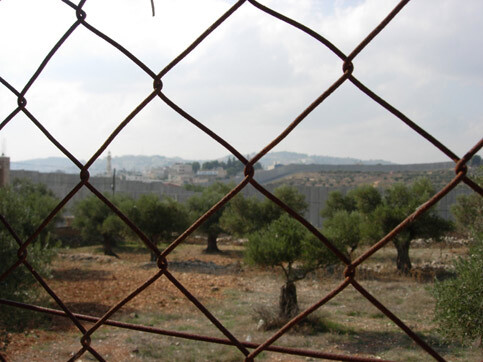
Standing in front of the wall and looking to the right I saw the wall criss-crossing across the landscape and cutting Bethlehem off from her agricultural lands. (Emily Jacir)
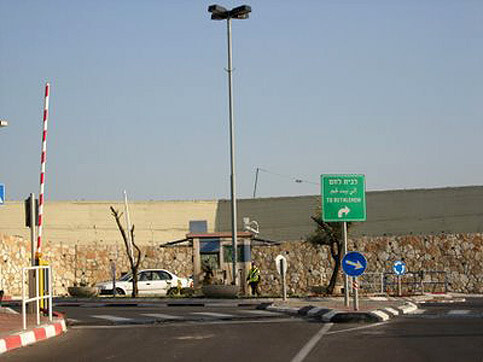
In order to enter Bethlehem, we had to make a left and get off the Jerusalem-Hebron Road. Here we are stopped at the first checkpoint and we are looking ahead. Soldiers check our passports. (Emily Jacir)
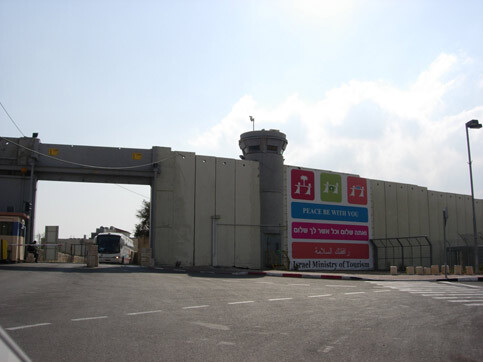
After passing through the first checkpoint, we made a right and we were able to enter Bethlehem through the large gate. You can see a tourist bus on its way out exiting the city. Palestinian ID holders cannot enter or exit from here. (Emily Jacir)
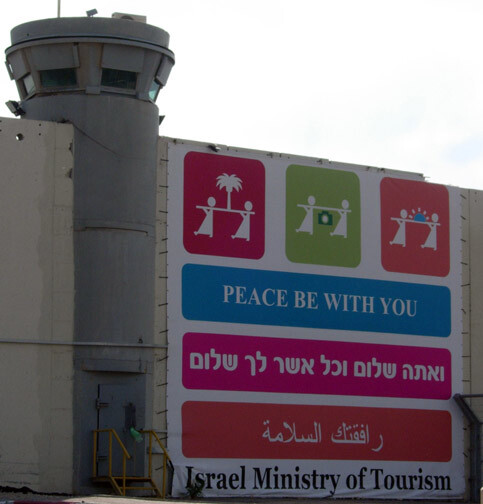
The Israeli Ministry of Tourism hung up a poster about “peace” on the wall which has turned the city of Bethlehem into a ghetto. (Emily Jacir)
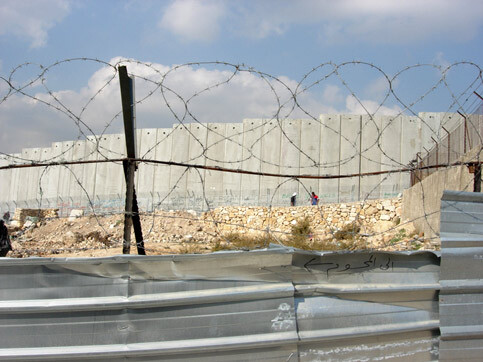
Once inside Bethlehem, I made a right to get back to the Jerusalem-Hebron road. (Emily Jacir)
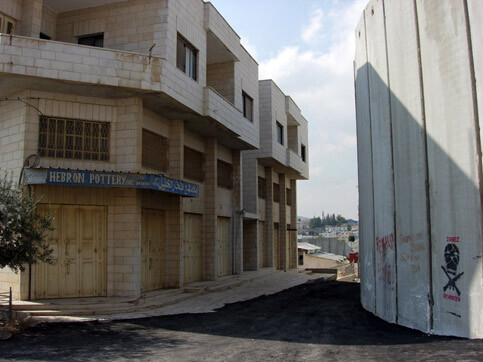
We got lost and ended up in what seemed like an endless maze of wall. (Emily Jacir)

Everywhere I looked I saw the wall, in all directions. Here we got out of the car and had to walk. I wanted to get to the Jerusaelm-Hebron Road and examine the area around Rachel’s Tomb and we couldn’t drive since the road was blocked, chopped and split in several places. (Emily Jacir)
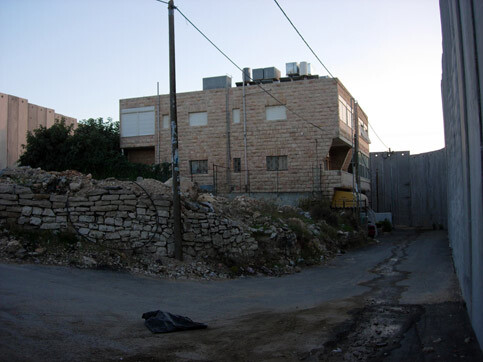
This is Clair Anastas’ house. It is surrounded by all three sides by the wall. (Emily Jacir)
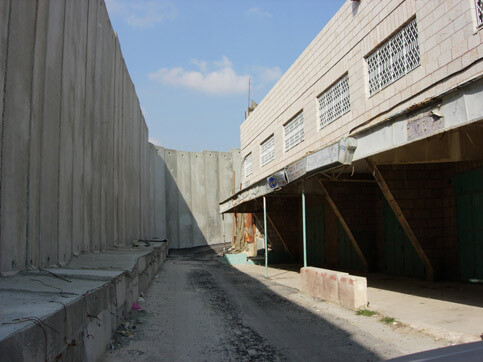
Back on the Jerusalem-Hebron Road, businesses have shut down as the wall has completely isolated them. There is no road here any longer — it is more like an alleyway — the rest of the formerly wide road is now on the other side of the wall, part of Rachel’s Tomb. (Emily Jacir)
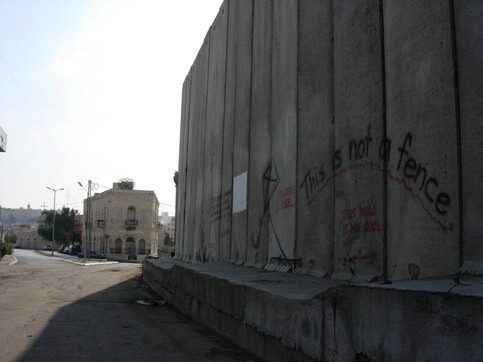
Facing the direction of Hebron, the Rachel’s Tomb complex on the right behind the wall. The road to the left of the house leads to Manger Square. Rachel’s Tomb and the surrounding area which they have enclosed behind the wall is all Bethlehem’s land. In September 2006 the Israeli government officially annexed it as part of Jerusalem. (Emily Jacir)
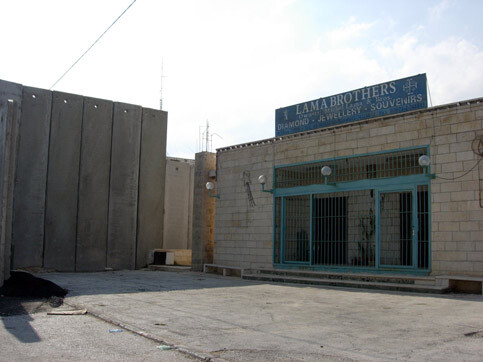
This is the view from the north side of Rachel’s Tomb, and the Lama Brothers souvenir shop cut off from the rest of Bethlehem. (Emily Jacir)
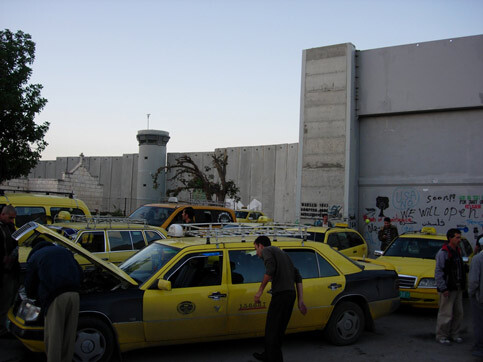
We backtracked and walked along the road in the direction of Jerusalem until we reached the wall. (Emily Jacir)

This is the south side of Rachel’s Tomb. Rachel’s Tomb now has two settler families living in it. They are building a yeshiva and plan to have 400 apartments for Israeli settlers. It won’t be long until Bethlehem ends up like Hebron. (Emily Jacir)
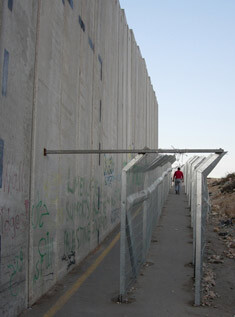
This is where Palestinian ID holders have to line up to enter or exit. There will only be two entrances in and out of Bethlehem. (Emily Jacir)
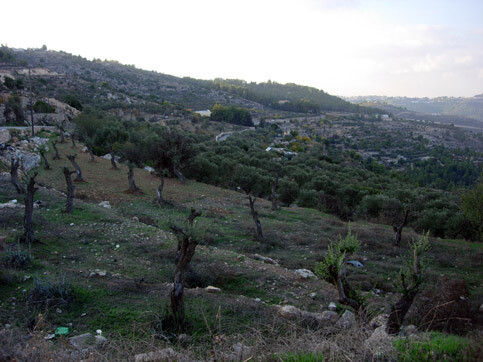
We went back up to the car and found our way back to the Jerusalem-Hebron Road past Rachel’s Tomb, but to get to Hebron we made a right at Bab Al-Zaq and headed to Beit Jalla instead of going straight. There was no way to stay on this road as it was cut off again before Deheishe Camp. We stopped at the top of Beit Jalla to see the olive trees the Israelis had chopped down. This marks the route of the wall as it snakes its way up here. All of Beit Jalla’s agricultural lands will be on the other side cut off from her people. The next time I stand here I will not be able to see this vista; I will only see grey concrete. (Emily Jacir)

This is Hebron’s old market. The last time I was here was in 2000. It was a bustling commercial and cultural area then. Now it is a ghost town. The city of Hebron is surrounded with checkpoints, road blocks and military barriers cutting roads leading to other parts of the city. The most violent settlers in the West Bank live in the center of Hebron in homes they stole from Palestinians. They routinely attack Palestinians in an effort to get them to leave. They are heavily guarded by 2,000 members of the Israeli army. (Emily Jacir)
This photo essay was taken the day I tried to follow Bus Number 23’s route, my father’s daily commute to Hebron.
He was right.
They have completely encircled us, not only by the settlements, but by the wall and the by-pass roads.
Bethlehem is a ghetto.
Emily Jacir is a Palestinian artist who lives between Ramallah and New York City.
Related Links



